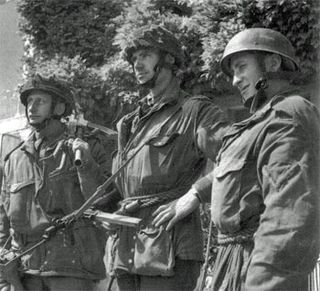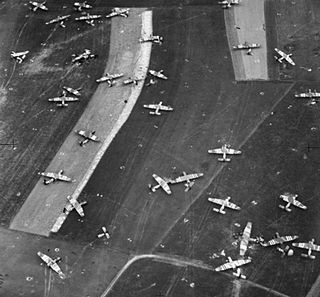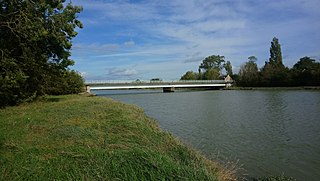
Operation Tonga was the codename given to the airborne operation undertaken by the British 6th Airborne Division between 5 June and 7 June 1944 as a part of Operation Overlord and the D-Day landings during World War II.

Pegasus Bridge, originally called the Bénouville Bridge after the neighbouring village, is a road crossing over the Caen Canal, between Caen and Ouistreham in Normandy. The original bridge, built in 1934, is now a war memorial and is the centrepiece of the Memorial Pegasus museum at nearby Ranville. It was replaced in 1994 by a modern design which, like the old one, is a bascule bridge.

Bénouville is a commune in the Calvados department in the Normandy region in northwestern France.

The Oxfordshire and Buckinghamshire Light Infantry was a light infantry regiment of the British Army that existed from 1881 until 1958, serving in the Second Boer War, World War I and World War II.

Major Reginald John Howard DSO was a British Army officer who led a glider-borne assault that captured the Caen canal and Orne river bridges on 6 June 1944, as part of the D-Day landings during the Second World War. These bridges spanned the Caen Canal and the adjacent River Orne, and were vitally important to the success of the D-Day landings. Since the war, the bridge over the canal has become known as "Pegasus Bridge," a tribute to the men who captured it. The bridge over the River Orne later became known as Horsa Bridge after the Horsa gliders that carried troops to the bridges.

Lieutenant Herbert Denham Brotheridge was a British Army officer who served with the 2nd Battalion, Oxfordshire and Buckinghamshire Light Infantry during the Second World War. He is often considered to be the first Allied soldier to be killed in action on D-Day, 6 June 1944. He was killed during Operation Tonga: the British airborne landings which secured the left flank of the invasion area before the main assault on the Normandy beaches began.

The 5th Parachute Brigade was an airborne forces formation of brigade strength, raised by the British Army during the Second World War. Created during 1943, the brigade was assigned to the 6th Airborne Division, serving alongside the 3rd Parachute Brigade and the 6th Airlanding Brigade.
Air landing is a designation formerly held by glider-borne infantry units of the British Army. Air landing units included infantry battalions and light armoured regiments together with combat support and combat service support units and sub-units. The Glider Pilot Regiment provided the aircrew to fly the gliders into battle. Although combat support and combat service support units had the term air landing as part of their unit title, for example 1st Air landing Light Regiment Royal Artillery, infantry battalions' names remained unchanged. All units wore the maroon beret of airborne forces with their own regimental capbadge.

The 6th Airlanding Brigade was an airborne infantry brigade of the British Army during the Second World War. Created during May 1943, the brigade was composed of three glider infantry battalions and supporting units, and was assigned to the 6th Airborne Division, alongside the 3rd and 5th Parachute Brigades.
Colonel Henry John Sweeney MC, known as Tod Sweeney, was an officer of the British Army. During the Second World War he was a platoon commander in the coup de main operation, by gliderborne troops of the 2nd Battalion, Oxfordshire and Buckinghamshire Light Infantry, on D-Day, 6 June 1944, tasked to seize Horsa Bridge and Pegasus Bridge before the main assault on the Normandy beaches began. The following day he was awarded the Military Cross for rescuing a wounded member of his platoon while under heavy fire near Escoville. Sweeney commanded the 1st Green Jackets at Penang from April 1962 to January 1964; during the Brunei Revolt and Indonesia-Malaysia confrontation.
Colonel David James Wood MBE was the last surviving officer of the coup de main operation carried out by glider borne troops of the 2nd Oxfordshire and Buckinghamshire Light Infantry, on D Day, 6 June 1944, tasked with capturing Pegasus Bridge and Horsa Bridge before the main assault on the Normandy beaches began.

Operation Mallard was the codename for an airborne forces operation, which was conducted by the British Army on 6 June 1944, as part of the Normandy landings during the Second World War.

Horsa Bridge, also known as Ranville Bridge, over the Orne river, was, along with Pegasus Bridge, captured during Operation Tonga by gliderborne troops of the 2nd Oxfordshire and Buckinghamshire Light Infantry in a coup de main operation in the opening minutes of D-Day, 6 June 1944. The seizing of both bridges was considered to be critical to securing the eastern flank of the Normandy landings area, preventing German armour from reaching the British 3rd Infantry Division which was due to start landing on Sword at 07.25hrs. Horsa Bridge, a road bridge, was over 400 yards east of Pegasus Bridge towards the village of Ranville.

The capture of the Caen canal and Orne river bridges was an operation by airborne forces of the British Army that took place in the early hours of 6 June 1944 as part of the Normandy landings of the Second World War. The objective was to capture intact two road bridges in Normandy across the River Orne and the Caen canal, providing the only exit eastwards for British forces from their landing on Sword Beach. Intelligence reports said both bridges were heavily defended by the Germans and wired for demolition. Once captured, the bridges had to be held against any counter-attack, until the assault force was relieved by commandos and other infantry advancing from the landing beach.
Major Frederic Balfour Scott MC was a British Army officer who was awarded a Military Cross for gallantry whilst serving with the 2nd Battalion, The Oxfordshire and Buckinghamshire Light Infantry in Normandy during the Second World War.
Captain Ridley Hugh Clark MC was a British Army officer who was awarded a Military Cross for gallantry whilst serving with the 2nd Battalion, The Oxfordshire and Buckinghamshire Light Infantry during Operation Varsity: the airborne operation over the Rhine on 24 March 1945.
Major Dennis Barraclough Fox MBE (1920-1993) was an officer of the British Army. During the Second World War he led the first platoon to land at Horsa Bridge in the gliderborne 2nd Battalion, Oxfordshire and Buckinghamshire Light Infantry coup de main operation, during the opening minutes of D-Day, 6 June 1944, which captured the Caen canal and Orne river bridges. These bridges were considered to be critical to securing the eastern flank of the Normandy landings area.
The No. 6 Beach Group was a unit of the British Army during the Second World War. It was responsible for organising the units landing on Sword in the Normandy landings on D-Day, 6 June 1944. The Beach Group was tasked with establishing dumps of equipment and supplies including ammunition, petrol and vehicles. The Group controlled all policing and unloading in the eastern flank of the Normandy invasion area.
Colonel Peter Gerahty CBE was one of the last surviving British Army officers to have served with 6th Airborne Division in Operation Varsity on 24 March 1945: the largest airborne operation in the history of warfare, part of Operation Plunder: the Rhine Crossing in March 1945. He was later appointed a CBE for his work on combat development with the Ministry of Defence.
Colonel John Maurice Arthur Tillett was a British Army officer who had a critical role in the planning of the capture of the Caen canal and Orne river bridges on D-Day, 6 June 1944, during the Second World War. He was one of the last surviving British Army officers to have served with the 6th Airborne Division in Operation Mallard, on 6 June 1944, and in Operation Varsity, on 24 March 1945. He later commanded the Ugandan Army.










